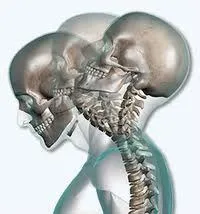Call Twisted Spine & Joint for your auto injury 214-618-3991
Injuries Resulting from Whiplash Trauma

Neck pain
It is the single most common complaint in whiplash trauma, being reported by over 90% of patients. Often this pain radiates across the shoulders, up into the head, and down between the shoulder blades. Whiplash injuries tend to affect all of the tissues in the neck, including the facet joints and discs between the vertebrae, as well as all of the muscles, ligaments and nerves.
Facet joint pain is the most common cause of neck pain following a car accident. Facet joint pain is usually felt on the back of the neck, just to the right or left of center, and is usually tender to the touch. Facet joint pain cannot be visualized on x-rays or MRIs. It can only be diagnosed by physical palpation of the area.
Disc injury is also a common cause of neck pain; especially chronic pain. The outer wall of the disc (called the anulus) is made up of bundles of fibers that can be torn during a whiplash trauma. These tears, then, can lead to disc degeneration or herniation, resulting in irritation or compression of the nerves running through the area. This compression or irritation commonly leads to radiating pain into the arms, shoulders and upper back, and may result in muscle weakness.

Headaches
After neck pain, headaches are the most prevalent complaint among those suffering from whiplash injury, affecting more than 80% of all people. While some headaches are actually the result of direct brain injury, most are related to injury of the muscles, ligaments and facet joints of the cervical spine, which refer pain to the head. Because of this, it is important to treat the supporting structures of your neck in order to help alleviate your headaches.
TMJ problems
A less common, but very debilitating disorder that results from whiplash is temporomandibular joint dysfunction (TMJ). TMJ usually begins as pain, clicking and popping noises in the jaw during movement. If not properly evaluated and treated, TMJ problems can continue to worsen and lead to headaches, facial pain, ear pain and difficulty eating. Many chiropractors are specially trained to treat TMJ problems, or can refer you to a TMJ specialist.
Brain injury
Believe it or not, mild to moderate brain injury is common following a whiplash injury, due to the forces on the brain during the four phases mentioned earlier. The human brain is a very soft structure, suspended in a watery fluid called cerebrospinal fluid. When the brain is forced forward and backward in the skull, the brain bounces off the inside of the skull, leading to bruising or bleeding in the brain itself. In some cases, patients temporarily lose consciousness and have symptoms of a mild concussion. More often, there is no loss of consciousness, but patients complain of mild confusion or disorientation just after the crash. The long-term consequences of a mild brain injury can include mild confusion, difficulty concentrating, sleep disturbances, irritability, forgetfulness, loss of sex drive, depression and emotional instability. Although less common, the nerves responsible for your sense of smell, taste and even your vision may be affected as well, resulting in a muted sense of taste, changes in your sensation of smell and visual disturbances.
Dizziness
Dizziness following a whiplash injury usually results from injury to the facet joints of the cervical spine, although in some cases injury to the brain or brain stem may be a factor as well. Typically, this dizziness is very temporary improves significantly with chiropractic treatment.
Low back pain
Although most people consider whiplash to be an injury of the neck, the low back is also commonly injured as well. In fact, low back pain is found in more than half of rear impact-collisions in which injury was reported, and almost three-quarters of all side-impact crashes. This is mostly due to the fact that the low back still experiences a tremendous compression during the first two phases of a whiplash injury, even though it does not have the degree of flexion-extension injury experienced in the neck.
Recovery from Whiplash
With proper care, many mild whiplash injuries heal within six to nine months. However, more than 20% of those who suffer from whiplash injuries continue to suffer from pain, weakness or restricted movement two years after their accident. Unfortunately, the vast majority of these people will continue to suffer from some level of disability or pain for many years after that, if not for the rest of their lives.

Chiropractic Care
Chiropractic care utilizes manual manipulation of the spine to restore the normal movement and position of the spinal vertebrae. It is by far the single-most effective treatment for minimizing the long-term impact of whiplash injuries, especially when coupled with massage therapy, trigger point therapy, exercise rehabilitation and other soft tissue rehabilitation modalities.
Soft Tissue Rehabilitation
The term 'soft tissue' simply refers to anything that is not bone, such as your muscles, ligaments, tendons, nervous system, spinal discs and internal organs. During a whiplash injury, the tissues that are affected most are the soft tissues, the muscles, ligaments and discs in particular. In order to minimize permanent impairment and disability, it is important to use therapies that stimulate the soft tissues to heal correctly. These include massage therapy, electro-stimulation, trigger point therapy, stretching and specific strength and range of motion exercises.
Home Care
The most effective chiropractic care and soft tissue rehabilitation will be limited in its benefit if what you do at home or at work stresses or re-injures you on a daily basis. For this reason, it is important that your plan of care extend into the hours and days between your clinic visits to help speed your recovery. Some of the more common home care therapies are the application of ice packs, limitations on work or daily activities, specific stretches and exercises, taking nutritional supplements and getting plenty of rest.
Medical Intervention
In some severe cases of whiplash, it may be necessary to have some medical care as part of your overall treatment plan. The most common medical treatments include the use of anti-inflammatory medications, muscle relaxants, trigger point injections and, in some cases, epidural spinal injections. These therapies should be used for short-term relief of pain, if necessary, and not be the focus of treatment. After all, a drug cannot restore normal joint movement and stimulate healthy muscle repair. Fortunately, surgery is only needed in some cases of herniated discs, when the disc is pressing on the spinal cord, and in some cases of spine fractures.
